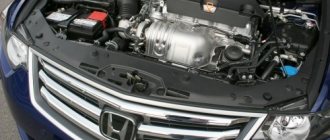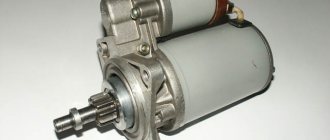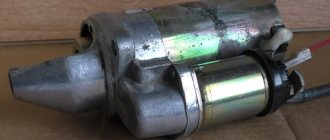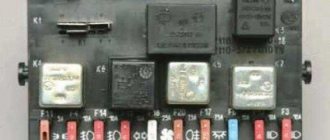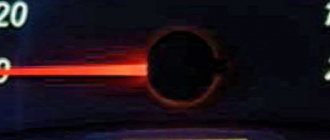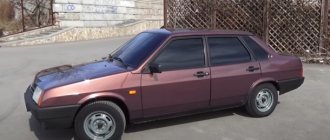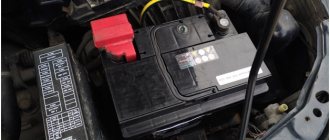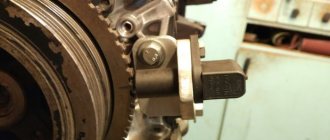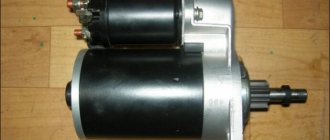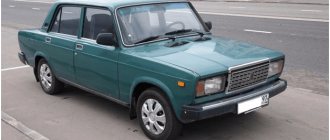07/18/2021 5 100 Ignition system
Author: Ivan Baranov
Many motorists have found themselves in an unpleasant situation in the morning when the car does not start. For example, the starter does not click, but it turns or turns with difficulty. Why is this happening? The reason may be a malfunction of the ignition system. The article discusses situations where the starter spins for a long time and provides ways to eliminate the problem.
[Hide]
The starter clicks but does not turn: causes and solution to the problem
Many drivers have encountered such an unpleasant situation when the starter does not want to turn the engine and start the car.
And it’s not a matter of the battery, because even no attempts are made to move the power unit. There is just a kind of click and nothing else happens. In such a situation, you have to push start the car or come up with other ways to start the engine. If the starter clicks but does not turn, there are several types of car problems that are worth paying attention to. This problem will have to be solved immediately after it occurs, because further movement is only possible with a working starter. Especially when it comes to large cars, which cannot be started from a pusher.
The starter makes a few characteristic clicks, but does not turn the engine.
The first scenario for the development of the situation in this case will be the occurrence of several successive clicks. If you listen closer to the unit, you can understand that these clicks are produced by the traction relay. This means that the starter takes an electric charge, but the current only reaches the traction charge, without passing to the engine spin-up mechanism itself.
Such manifestations are perceived by drivers as a discharged battery. The lack of charge in the battery would allow the starter to be cranked lazily once or twice, so this problem is excluded in this case. It is better to pay attention to the following possible problems:
- the traction relay is faulty and does not supply voltage to the starter itself;
- the relay contacts with the main part of the starter are too loose;
- poor ground from the starter to the engine body;
- loose contact on other terminals connected to the starter.
Remember that the correct operation of the device is ensured only by the full functionality of the vehicle's electrical system. All it takes is one small misconception and the starter will click but not turn. Therefore, first of all, if such a problem occurs, check all connections and contacts in the starter. This will help you completely eliminate the problem or force the starter to spin and start the engine once and drive to the diagnostic center.
The starter makes one powerful click and does not turn the engine.
In such a situation, the list of problems comes down solely to the starter itself. We again confirm the fact that the charge is reaching the starter, because the relay clicks. A malfunction of the relay itself is excluded, because some kind of problem is blocking the normal operation of the device.
One powerful click and no further action from the starter may be the cause of an unstable charge being supplied to the device. Try to try to start the engine several times at intervals of 15-20 seconds. You may be able to start the engine. If this does not happen, it is worth investigating the following possible problems:
- the starter bendex is faulty, it is jammed and does not allow the entire device to turn;
- the retractor is broken and does not regulate the starter;
- break in the starter main winding or short circuit inside it;
- The starter brushes or bushings are maximally worn and require immediate replacement.
In any situation, you need to contact specialists to fix the problem. If you have a similar problem, but the car continues to start on the second, third or fifth attempt, you still need to solve this problem. Otherwise, one day the starter will stop working and force you to look for alternative ways to start the engine.
Do not rush to buy a new starter if you encounter such a problem. It is likely that the old device can serve for quite a long time. You just need to carry out high-quality maintenance and check all the electrical parts of this module.
How to fix a problem with the starter?
It is better to entrust the correction of any problem associated with such an important element of the car only to specialists. They guarantee high-quality diagnostics and will be able to find a problem in your starter, which will lead to a real elimination of all problems. If you cannot start the car in any other way, you need to do the following:
- remove the starter with wires from the car;
- deliver the device to a professional service station;
- describe the behavior of the starter to the service employees;
- ask for repairs to be carried out as quickly as possible.
Then you need to check the functionality of the starter at the service center, bring the device back to the car and install it in its proper place. This way you can get a working car as quickly as possible and not lose several days on repairing the starter.
Video:
Let's sum it up
If the starter clicks but doesn't turn over, you have several options to solve the problem. First you need to check all contacts visible from the outside and make several attempts to start the engine. You also need to try installing the ground on the car body.
If this does not help, you should call specialists to repair the starter or take the device to a service center. With these steps you can return your car to working condition. Have you ever had similar problems with the starter, and how did you get out of them?
Why does the anchor rotate slowly?
When such problems arise, experienced drivers first of all go to check the condition of the terminals connecting to the battery. They may be oxidized or poorly clamped. If this is the case, the problem can be solved by removing the oxides, tightening the fasteners and coating this joint with CIATIM 201 lubricant. What to do if this does not happen? You should continue to look for a bad connection.
In some car models, there is access to the starter; in this case, you should try to forcibly close the power terminals of the solenoid relay. Reliable operation of the starter will confirm the malfunction of the retractor relay, and if even after this the start is unsuccessful, you will have to remove the starting device from the car. This operation is not very labor-intensive, but on some models it is quite inconvenient to carry out. However, to troubleshoot problems you will have to do it.
Before you begin disassembling and searching for a defect in this device, you should check the connection of the power wires to the bolts of the solenoid relay. Large currents consumed by the starting device cause, in some cases, heating of this connection. After repeated occurrence of this phenomenon, contacts are broken, resulting in slow rotation of the armature. You should unscrew the nuts from both power bolts of the solenoid relay, thoroughly clean the contacts, and restore the connection again. At this time, you should also check the reliability of the connection of the power winding with the output terminal, the condition of which may make it impossible to start the engine.
Next, you should disassemble and carefully inspect all the parts of this device. After long-term use, they naturally wear out. Such parts primarily include brushes and bushings in which the armature rotates. They are made of copper-graphite alloy, which is subject to abrasion. If this happens, then during rotation of the armature it will be pressed against the power windings, which will cause braking of the rotation of the shaft. In this case, drivers say that the starter takes over.
In such cases, the worn bushings are usually pressed out, new ones are installed instead and unrolled to the required size, after which the device is assembled and tested in operation. As you can see, problems exist. We talked about some problems why the starter turns as if the battery was dead. It may happen that there are other reasons for such problems, but the ways to find them can be used from this story.
You turn the ignition key, but instead of the vigorous rhythm of the running engine, you hear that the starter is turning the engine, as if the battery is dead. Another attempt to start the engine. And further. Stop: until the battery really requires charging, and the car is not sent on a tow truck for service, it is worth remembering how to check the starter without removing it from the car, and even fix the breakdown. To identify the malfunction, you will have to remember the operating principle and design of the starter.
The car won’t start – we check the main possible problems
The most common problem with a vehicle's engine or electrical system is a lack of ignition. There are different options for the implementation of this breakdown, so you need to know the difference in order to determine the specific unit to blame for the failure to start the engine. The starter may spin, click or be silent, the engine may start and immediately stall, and also make sounds that are unusual for it. It is worth dealing with these manifestations so as not to make the breakdown even more complicated.
Firstly, if the car does not start, you should stop trying to start the engine until the problem is clarified. The timing belt may have broken on the car, and your successive attempts to start the engines will lead to valve failure. Let's look at the main possible manifestations of problems that cause poor engine starting.
Problems with the starter and electrical system of the car
Often the answer to the question of why the car won’t start lies on the surface. Poor performance of the starter or its complete failure is the cause of 80 percent of problems with starting the power unit. Therefore, first of all, check this unit for its correct operation.
Also, starting the engine can be complicated by a dead battery or a broken wire in the car's electrical system. The wire leading from the battery to the starter often breaks, and the car does not respond at all to turning the key in the ignition. Manifestations of problems with the starter are as follows:
- when turning the key in the ignition switch, only a click is heard in the starter area;
- the unit constantly makes clicking noises, but does not turn the engine;
- there is no reaction from the car to an attempt to start the car with the key;
- The starter turns, but makes strange sounds of rapid rotation.
In the latter case, the culprit of the problem will be the bendix, which should move out of the starter and turn the engine. This element often wears out and does not perform its tasks. The first types of problems are related to the solenoid relay. Replacing it can often solve this problem.
If your car's battery is dead, the starter will only turn once or twice without starting the engine. Lazy sounds under the hood also mean a dead battery. In all these cases, you can easily start the car from a pusher or with the help of a tow, and in the event of a battery failure, you can light a cigarette from the battery of another car.
Problems when starting the engine related to the power unit system.
Often problems with starting the engine are based on problems with the unit itself, and in this case you need to be much more attentive to extraneous sounds and other possible manifestations of the problem. If the engine knocks during startup, a possible problem is hidden in the piston group or in the valves. The ignition setting may also be lost.
Here everything depends not only on the operating characteristics of the car, but also on the type of engine itself. In some units you can try to find the problem yourself; in the case of modern foreign equipment, you will have to evacuate the car to a service station. The main problems that occur in the engine system and prevent the car from starting are the following:
- timing belt breakage or its displacement from the established marks;
- broken ignition timing setting, which often happens on carburetor cars;
- poorly configured valves that prevent the engine from starting normal autonomous operation;
- deformation of the valves due to impact when the belt breaks or other mechanical damage.
Also, the car may well not start due to low octane gasoline or poor fuel quality. Diesel engines can be difficult to operate in winter due to possible fuel freezing. The more technology and automatic solutions are present in a car, the more possible problems can be found.
If you understand that the problem of the power unit not starting is not related to the battery or starter, stop trying to start the engine, because you can only make things worse. It is better to invite a specialist or tow the car to a professional station to detect and fix problems.
See what a broken timing belt can lead to on some cars:
Let's sum it up
If your car refuses to start, you shouldn’t torture it with every second attempts to turn the key in the ignition system in an effort not to be late for work. Use the services of a specialist to identify possible problems and get more information about the problem. Then you can easily detect the breakdown and fix it.
If the engine does not start for more serious reasons, the service station will tell you possible ways to fix the problem. It is enough to find specialists who are well versed in your make and model of car. Are there any situations in your driving experience when it was very difficult to determine the reasons for the failure of the power unit to start?
During the operation of any vehicle, various incidents arise. For example, drivers are well aware of the situation when the starter gets hot and turns poorly when the battery is charged. This makes it impossible for the power unit to start normally, so it is worth analyzing the possible causes of this malfunction.
Causes of problems
A malfunction may occur as a result of breakdowns of the following components:
- Bendix (overrunning clutch).
- Solenoid relay.
- Driven and drive gears
Bendix acts as a coupling, through which torque is transmitted from the electric motor to the crankshaft. A malfunction of the overrunning clutch most often causes a breakdown manifested in the form of idle cranking of the starter.
Breakdowns of the retractor relay are much less likely to cause a malfunction when the starter turns but does not engage the flywheel. Most often, this symptom is observed when the winding is shorted or when the battery is faulty.
During long-term operation of the vehicle, the flywheel and starter crown wear out significantly, which can also lead to idle cranking of the electrical device for starting the engine.
All of the above types of faults, even if you have a little experience in car repairs, can be eliminated on your own.
Starter repair
To accurately diagnose the parts of an electrical device, it must be dismantled. To eliminate the possibility of a short circuit while working, you should disconnect the negative terminal from the battery.
It is very easy to determine a bendix malfunction leading to the device spinning. To do this, just try to rotate the gear in both directions. If rotation is possible in both directions, the overrunning clutch will need to be replaced.
Even if you have a repair kit or a used part from another car, it is recommended to purchase a new unit.
If the electric starter malfunction is caused by significant gear wear, then there are 2 possible solutions:
- Gear replacement.
- Bendix replacement.
In both cases, the quality of the repair will be high enough to continue operating the vehicle as usual.
Flywheel repair
If, from the moment the first signs of a starter malfunction appeared, the machine was operated for a sufficiently long time, then the toothed surface of the flywheel (rim) will also undergo significant wear.
Unlike replacing the starter gear, the engine flywheel is not as easy to remove. On a rear-wheel drive car, work is performed in the following sequence:
- The driveshaft is dismantled along with the intermediate supports.
- The starter is removed.
- The gearbox is being removed.
- The clutch is dismantled.
- The flywheel is removed.
After removing the flywheel, a new part is installed, and the car is reassembled in the reverse order.
If all the teeth on the flywheel ring are intact, and there is wear on only one side, then on many cars the problem can be completely eliminated by turning the ring over.
This operation is performed in the following sequence:
- Carefully knock the crown off the flywheel.
- Heat the part.
- Install the crown onto the flywheel with the reverse side.
Purpose and features of the starter
This element in the power unit starting system is necessary to spin the crankshaft, since without this procedure any vehicle simply cannot start. If for some reason the starting device stops spinning the crankshaft until it reaches the required speed, problems arise with starting the engine.
Do not confuse a non-working starter with a mechanism that does not turn the engine well, since these are two opposite states of the element. Therefore, every car owner needs to learn to distinguish between these conditions and diagnose their causes.
Before performing a device test, it is necessary to check the charge of the power source, since the correct starting of the engine depends on it. If the battery is not charged well enough, the starter will no longer be able to spin the crankshaft.
The starter turns poorly when the battery is charged
This situation causes the most confusion among the average car enthusiast. The battery is fully charged. Moreover, it is completely new. Even the weather outside is warm, there is no frost. But the starter still turns poorly. Why?
Here are some possible reasons:
- The engine has a lot of resistance to the starter. This, for example, can be observed the first time after a major overhaul of the power unit. Not all the parts have gotten used to each other yet, and putting it all into motion requires enormous effort. The same thing happens with a technically faulty engine - something is stuck somewhere, worn out, and so on.
- The car was idle for a long time. When the machine is not used for a long time, oil flows from all the rubbing parts of the crank and gas distribution mechanisms into the sump. The friction force between the parts increases many times and, as a result, the starter turns poorly.
- Gearbox problems. If, when the clutch pedal is pressed, the starter seems to come to life and turns much more willingly, then something is wrong with the gearbox.
- The starter itself is to blame. The brushes are worn out, the commutator is clogged, there is significant play in the bushings, water or dirt has entered the starter. How to “cure” all this with your own hands is described at the end of this article.
Go ahead.
Reasons why the starter turns slowly
Before carrying out a complete diagnosis of the starter, it is necessary to test its performance on a cold power unit and after it has warmed up. To do this, it is enough to try to start a cold engine, then start it again, warm it up to operating temperature and turn it off, then retest it. A properly working starter should start the vehicle engine in any of these modes.
Common problems that prevent the engine from starting normally include:
- Thick grease in the motor.
- Low power supply.
- Making starter bushings or brushes.
- No negative contact (ground).
- Bendix failure.
- Incorrect operation of the solenoid relay.
- Lack of contact between commutator and brushes.
- Short circuit of turns or their breakage.
The operation of the starter completely depends on the temperature of the system, so auto mechanics always recommend testing its performance, both on a warm engine and on a cold one. We will describe this in detail.
Reasons for slow rotation
We are interested in the moment when the starter rotates at low speed. This makes starting the internal combustion engine problematic. A priori, the reason for this behavior of the starter is related to the battery, the condition of which leaves much to be desired, but this is not the point. Let's assume that the battery is reliable, the acid has been replaced and the charge is present.
The starter does not turn
The reason for the starter turning slowly may be due to things like oxidation of the terminals or loose connections. In this case, it is recommended to clean the oxides, tighten the clamps and treat the elements with a suitable lubricant. If starting does not improve, you need to continue troubleshooting.
Many vehicles have easy access to the starter device and its traction relay. In this case, it will be much easier to check whether the starter is working if you start it directly. In other words, the closure of the power terminals of the relay is carried out forcibly, which will make it possible to confirm the malfunction of the solenoid relay (VRS) based on reliable operation of the starter. On the contrary, if the start is unsuccessful, the starter will have to be removed and repaired.
Why does the starter turn poorly when hot?
In this state of the system, the reasons for the inability to start the engine are as follows:
- wear out or jamming of bushings;
- problems with the crankshaft (imbalance, wear of liners, etc.).
Such problems are a consequence of the deterioration of elements of the starting system of the motor unit. In addition, the situation is significantly aggravated by high temperature. If this is observed constantly, immediately go to the nearest car service center to diagnose the system, otherwise the engine crankshaft or the unit itself may fail. The cost of repair work in this case will be high.
Why does the starter turn poorly when cold?
In this state of the system, the problems are not so significant and are mainly associated with the effect of low temperature on the working fluids. The starter does not work well for the following reasons:
- low efficiency of the battery due to loss of its capacity due to decreased temperature;
- Thickening of the oil inside the engine as it starts cold.
Note that if the starter works equally poorly in both modes, the reasons for this must be sought among the most common. They are often associated with a malfunction in the starting device, or a lack of contact in the vehicle’s electrical network. The causes of problems can only be identified by diagnosing the device.
Advice to a car owner
All external contacts of the starter should be cleaned before checking, since this is a fairly common malfunction and there is no need to remove it from the engine.
Even an initial check of the starter without removing it from the vehicle usually indicates a breakdown, reducing repair time, reducing costs and not taking much time.
A large number of problems associated with a car's electrical system can be caused by poor contacts. Their appearance is associated with processes of chemical origin, in particular oxidation, or as a result of mechanical action. Thus, if problems are detected in the operation of the vehicle’s electrical system, manifested, for example, by malfunctioning headlights or the inability to start the car, you first need to very carefully check the connection to the battery ground. But in order to find out the reason for the poor performance of the starter, you should check for the presence of all possible causes that cause it.
Reasons for slow and ineffective starter operation:
Insufficient battery charge
A dead battery is not capable of cranking the engine for a long time. After a couple of cranking attempts, the starter goes silent and you can only hear relay clicks, which indicate that the battery is completely discharged. In this case, you need to charge the battery; if the problem occurs in cold weather, warm up the battery, use another battery or a special device, or replace the battery.
Using thick engine and transmission oil at sub-zero temperatures.
In severe frosts, using engine oil that is not intended for use in extreme temperatures is accompanied by the problem of oil thickening. This can also happen with transmission oil poured into the gearbox.
Problems connecting the ground to the starter
It is necessary to check the reliability of the connection of the negative battery ground wire with the starter solenoid relay. If necessary, strip the ground wire, then connect it to the solenoid relay. Additionally, you should check the condition of the wires and contact connections in the direction from the battery to the starter.
Worn bushings
If you find wear on the starter bushings, they must be replaced. But it should be noted that if the starter wears out excessively, this will not help for long. By placing washers under the bushings, you can eliminate the axial play that occurs on them.
There is a malfunction in the solenoid relay
Malfunction of the relay may be associated with burnout of the contact plates located in the relay, combustion of the relay winding, destruction or fatigue of materials.
Short circuit of the starter winding or armature to ground
The starter brushes are not making good contact with the commutator.
Bendix malfunction
Most often, when the starter is running slowly, it becomes necessary to service and repair the starter. High-quality repair of the starter can be carried out by qualified service center specialists.
The starter turns poorly
A starter is a mechanical element that serves to spin the crankshaft before starting the engine. This is a necessary procedure, because without such a push the car simply will not start. When the mechanism cannot spin the system to the required speed, serious starting problems arise.
It is worth noting that the difference between a non-working and a weak starter is colossal. The causes of such breakdowns are different, so it is initially worth diagnosing the condition of the mechanism and identifying signs of malfunction.
Before starting any diagnostics, it is important to check the most common cause - battery charge. To start the system, the device needs a charge drawn from the battery. If there is not enough voltage in it, then this is characterized by a sluggish start.
It is also worth determining whether this condition is temporary or not. If such problems arise once, then there is nothing to fear. If there is a regular malfunction of the device, then it is worth carrying out diagnostics.
Reasons for a cold or hot system
Since system temperature can affect the causes of starter problems, it is necessary to test its operation in both states - cold and hot. In the first case, the following problems may appear:
- thick oil;
- reduction in battery efficiency.
In a cold system, such a set is extremely small, because the low temperature here is dangerous only for liquids. However, when hot, the following problems are possible:
- bushing wedge;
- crankshaft failure (rubbing of liners, axle displacement, etc.);
- bushing wear.
Such problems more often arise on a well-developed system where the temperature has risen. If such a tendency is observed, it is recommended to check the system at a car service center. There may be problems with the crankshaft, which can lead to expensive car repairs.
If there is no difference between the operation of the starter in both cases, then it is recommended to look for reasons among the general ones. Most often, the problem is in the starting device itself or the power system.
Diagnostics
If the problem is not initially found, it is worth diagnosing the starter by disassembling it. To do this, you must first remove it from the system and carefully examine it.
During the removal process, it is worth checking adjacent parts. It is especially recommended to inspect the retractor relay, because this is where problems can arise. If there are oxidized contacts at the connection points, you need to clean them. It is also worth checking all connections for oxidation, because inappropriate operating conditions can cause destruction of the metal. This leads to wiring problems.
Next you need to grab the starter again. The following elements are checked in turn during the analysis process:
- bushings and brushes;
- armature winding;
- stator winding;
- bendix.
The remaining elements are not so important, because checking them is difficult, breakdowns often occur due to these parts. It is important to carefully diagnose their condition and interaction with other elements in order to detect possible traces of problems.
In particularly severe cases such as massive oxidation, destruction of several parts and other malfunctions, it is recommended to completely replace the starter. Even after repair, the reliability of such a device will be low, and a comprehensive repair will be more expensive than purchasing a new part.
How to diagnose and repair a starter yourself
In the case when the starting device does not work, and the power system is in good condition, this is a clear sign that it is time for repair work on the starter.
The faulty unit is located at the bottom of the engine. To remove it you will need an inspection hole and a standard set of tools.
After dismantling, it is necessary to completely disassemble the electric motor and reassemble the parts. Searching involves identifying faulty parts and then replacing them.
To avoid confusion when assembling an already repaired unit, it is necessary to make special marks on the parts using various sharp objects. This could be a nail, an awl or a metal scriber.
During the reassembly process, special attention should be paid to:
- Condition of contact connections (for example, brushes with commutator). If necessary, clean them.
- Bendix malfunctions. If its splines have become too worn, it must be replaced.
- Winding insulation condition. It should be intact and there should be no traces of burning on it. The anchor is also subject to various damages. One of its elements, the collector, must not have damage to the contact group. The plates should have a copper color. If they give out a blue tint, this means that the collector needs to be replaced.
